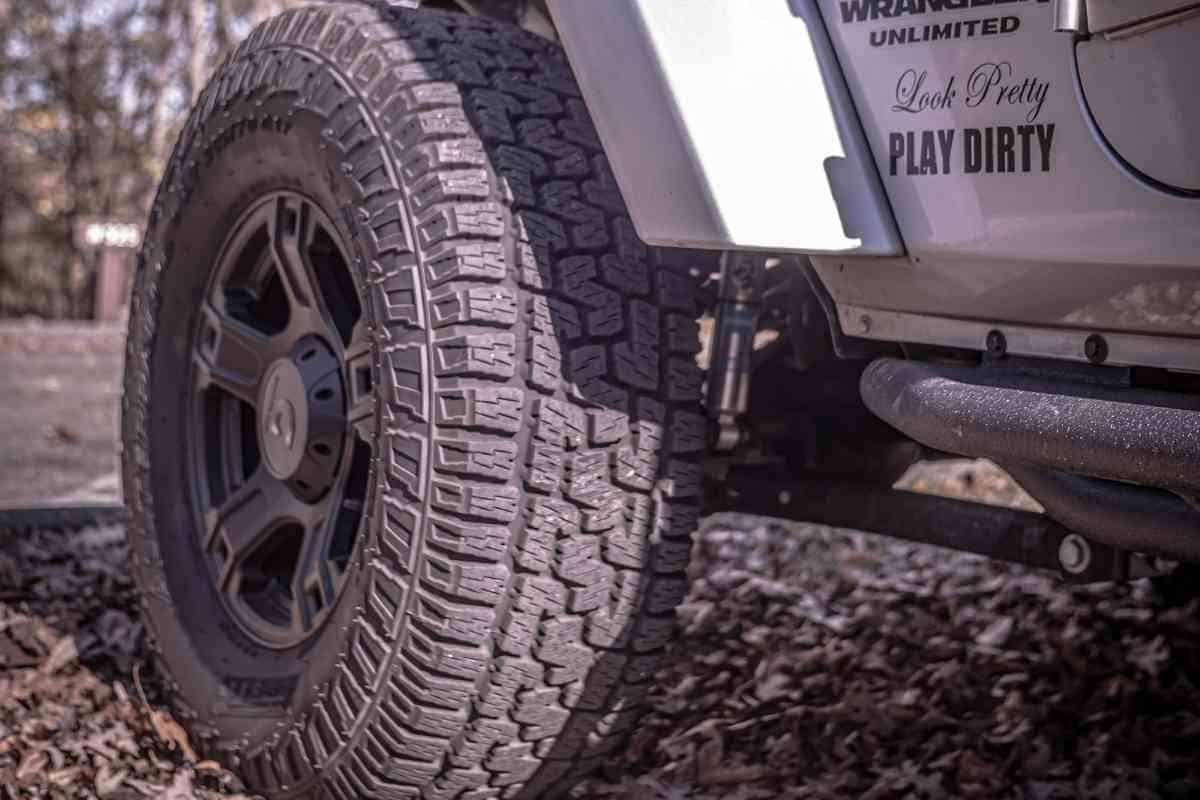Are 35-Inch Tires Really 35 Inches?
You might be surprised to learn that a 35-inch tire doesn’t always measure a full 35 inches. That’s because the amount of PSI or tire pressure can impact a tire’s size. Various rim widths can also impact the actual size of 35-inch tires.

While you are researching 35″ tires, check out our full tire section and these other popular articles: What Is the Actual Size of a 35-Inch Tire?, How to calibrate speedometer for bigger tires, 35 inch tires in metric, How Much Do 35 Inch Tires Affect Your Speedometer?, How Much Do 35 Inch Tires Affect Gas Mileage?, and Balancing 35 inch tires.
Are 35-Inch Tires Really 35 Inches?
When a 35-inch tire is properly inflated, it’s usually between 34 and 34.5 inches, so your 35 inch tires are not technically 35 inches in diameter in practice.. Most of the time, the tire size will read 315/70/17. However, a 35-inch tire’s size will read differently for various rim sizes.
You obviously want to match the right tire and rim size. Otherwise, you’ll run into problems down the road.
Keep reading to learn about the actual size of a 35-inch tire and how to match one to your vehicle’s rim dimensions.
35-Inch Tire Sizes for Various Rims
For all rim sizes, 35-inch tires can be either a half inch more or less in diameter. Here are the sizes for each rim dimension:
- 15-inch rim: 35X12.50-15
- 16-inch rim: 315/75-16
- 17-inch rim: 315/70-17 or 295/70-17
- 18-inch rim: 285/75-18, 295/70-18, 35X12.50-15, 305/70-18, 325/65-18
- 20-inch rim: 275/60-20, 285/65-20, 295/65-20, 315/60-20, 325/60-20, 35X11.50-20, 35X12.50-20, 35X13.50-20
- 22-inch rim: 35X12.50-22 or 325/50-22
- 24-inch rim: 325/45-24
You can also use an online tire size calculator for various rim sizes to calculate the actual size of your tires.
Does Tire Size Impact Performance?
Typically, the larger you go, the more performance you’ll see.
This is especially the case with off-road and high-performance vehicles like a Jeep.
However, you don’t want to exceed the recommended tire size for your car’s make and model.
Doing so could void one or more warranties on your car, including the original manufacturer’s drivetrain coverage.
This isn’t something you want to do, so be sure to check the fine print before you increase your car’s tire size.
Check for the Right Rim and Tire Size Combination
Another fine print point you’ll want to check is the manufacturer’s recommended rim and tire size combination.
For instance, Jeeps perform best with a 17-inch, 35-inch tire combination.
However, you may drive a Hyundai instead of a Jeep.
The first place to look is your owner’s manual. If you can’t find any information there, check online for published data from the manufacturer.
You can check forums but may get some conflicting advice and information.
You can also check with a dealership or major repair shop chain since they tend to work on a variety of vehicles.
They also have to follow the manufacturer’s recommendations for tires and other parts.

How Does the Rim Size Impact Tire Size?
As rim sizes get narrower, they also make the tire narrower. The opposite is also true. A wider rim will cause a tire to widen in size or diameter.
A tire manufacturer will provide the recommended range of rim sizes.
For example, a 35-inch tire made by one manufacturer may have a recommended rim size range of 15 to 18. Another tire manufacturer might recommend a rim range of 17 to 20.
Keep in mind these rims are not merely recommendations; they are the approved ranges.
If you try to go outside the recommended or approved ranges, you’re doing more than risking poor performance. You’re risking the integrity of the tires themselves.
Excessive wear and tear, damage, and blowouts are likely.
You will also run into handling problems while you’re driving. Expect to weave all over the road, which isn’t good for you or others.
A cop or state patrol will pull you over for erratic driving and violating any laws related to weaving between or within lanes.
What Do Different Rim Sizes Do?
Rims that are smaller or narrower impact the way your tires make contact with the asphalt or gravel on the road.
When rims are smaller, the tire tread is pulled away from making full contact. Wide rims make the tread move into the center.
When rims are too narrow or wide for 35-inch tires, you’ll run into problems. If you’re driving on gravel or unpaved roads, you’ll risk punctures from rocks or your tires peeling away from the rims.
What Kind of Tread Designs Are Available with 35-Inch Tires?
Since 35-inch tires are typically made for trucks and performance SUVs, available tread designs come in all-terrain, mud terrain, and street terrain.
Some vehicle owners prefer all-terrain tread designs because of their versatility.
You can drive on smooth asphalt in town and take your car on gravel or lightly mud-filled roads without having to switch out your tires.
Other owners like terrain designs for mudding because they mostly use their cars for off-roading, camping, and recreational purposes.
Street terrain designs are best for individuals who plan on driving on paved asphalt or in-town 100% of the time.
FAQs
Can I upgrade to 35-inch tires?
It will largely depend on your vehicle’s make and model.
If you currently have smaller tires, check with the manufacturer to see if it’s possible to install 35-inch tires without voiding your warranty.
If you can upgrade without voiding your warranty, the next step is to see what the recommended rim range is. It’s better to invest in larger or smaller rims if need be.
Does my car’s weight matter?
Yes, it does. That’s because different tire sizes are made to handle various loads. The maximum load for a set of 35-inch tires at certain PSI levels might be 10,000 pounds.
Check the tire manufacturer’s fine print to see what the ideal PSI levels and maximum weight loads are.
You don’t want to invest in a pair of tires that can’t handle the weight of your car, let alone any additional weight you might want to tow.
This includes small trailers for moving or full-blown campers.
A 35/12.50-15 tire can handle 2,555 pounds when it’s inflated to 35 PSI. However, this will vary by exact tire size, manufacturer, and PSI level.
It’s not a good idea to underinflate or overinflate a tire’s PSI to help carry more weight.
What kind of brands are available?
It will depend on the tire or auto care shop you purchase 35-inch tires from. However, some of the brands can include BF Goodrich, Toyo, and Milestar.
Major tire chains like Firestone probably also carry a range of store brands in the 35-inch size.
Should I buy a spare 35-inch tire?
If you’re upgrading your regular set of tires to the 35-inch size, you should also purchase a spare. You never know when you’re going to need it.
A flat can happen unexpectedly at any time.
Most SUVs and trucks have a convenient place to store your spare on the vehicle or within a hidden storage compartment.
What type of wheel rims can I get?
Most vehicles take either steel or aluminum alloy wheel rims. The advantages of aluminum alloy rims are that they’re light in weight and are usually stronger.
However, they’re not as flexible when it comes to straightening out dents or minor damage.
Steel wheel rims are generally easier to repair when they sustain minor damage.
Yet, they do weigh more and don’t always hold up as well.
References:
- https://www.4wd.com/article/content.jsp?childEventId=jeep-advisors-tire-wheel-advisor
- https://www.discounttire.com/products/tires/35-inch-tires
- https://www.tirebuyer.com/education/tire-diameter-chart
- https://www.wranglerforum.com/threads/which-tire-sizes-are-considered-35s.2233185/
- https://tiresize.com/height-calculator/
